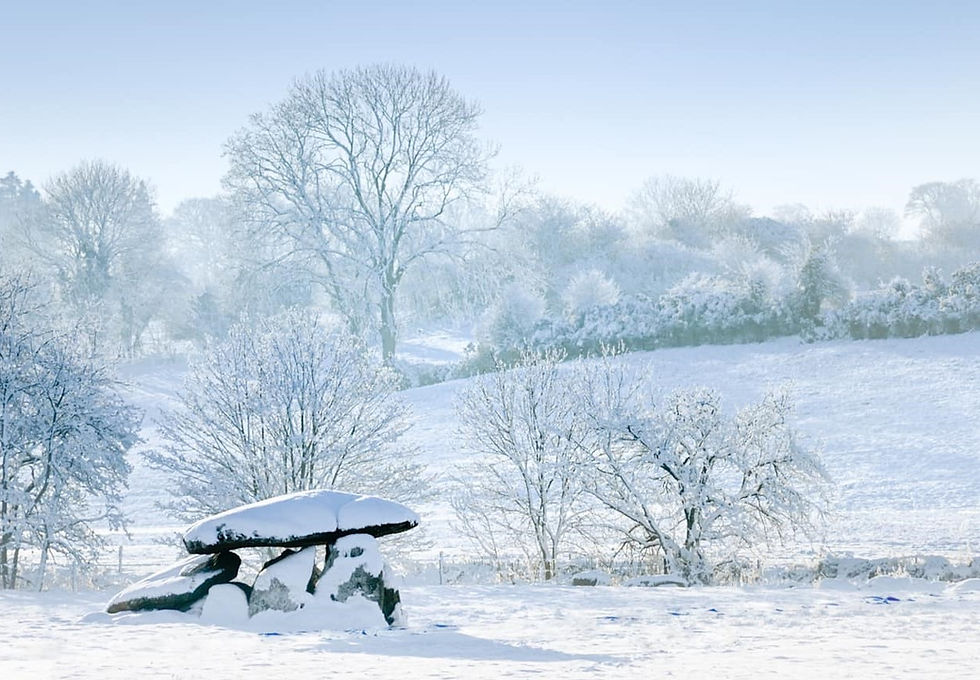The Winter Solstice and the Birth of Sol
- The heART of Ritual

- Dec 19, 2021
- 3 min read

We have almost arrived at the winter solstice, the moment when the most northern point of the earth is tilted furthest away from the sun. This results in the fewest hours of light and the most hours of darkness.
The word solstice itself means ‘still sun’ or ‘standing still sun’, depending on your definition preference. The sun will ‘appear’ to stand still at this point for 3 days after which it will begin to move again and the hours of light will begin to grow. The reason for this is because before and after the solstice the declination speed is less than 30 arcseconds per day which is undetectable to the naked eye.
Solstice myths often contain this auspicious moment of the renewal of the sun on the 25th of December. We can find this symbolism within the various ‘sun gods’ said to have been born at this time as well as the various ancient traditions which celebrated the re-emergence of both nature and life after the moment of the deepest dark.
It should be noted that the solstice is celebrated as a period known as midwinter but the point of astronomical solstice is only a moment in itself and does not always occur at the same time. Again, we can understand this in a much more comprehensive way using scientific instruments. Our ancestors most likely understood time differently and they certainly utilised their own astronomical, mathematical and construction knowledge in order to frame this time within the structures of their monuments. Although Newgrange is probably the most famous example, the growing discipline of archaeo-astronomy is discovering more and more ancient structures with celestial alignments.
Examples of ancient Midwinter and solstice celebrations are worldwide and too numerous to list but here are some of which people may have heard of and not known too much about.
Beginning with northern Europe we have the pagan festivals of Yule (Jul) which is associated with both Odin and The Wild Hunt. This was also supposed to be a time of heightened spirit activity and a person might encounter supernatural beings, fairies and ghosts by venturing out at night. Many of the Yule attributes are said to have emerged from pre-Bronze age customs of ancestor veneration which may account for these beliefs. This is a wide-ranging topic so I won’t delve too deeply into it in this short piece but there are lots of previous posts to help any interested reader discover the various scholarly findings and assertions relating to Yule.
Another example is the Iranian celebrations of Yalda night which come from Zoroastrianism. Zoroastrianism itself is said to date to before 2’000 BCE so this is another very ancient custom and observance of the solstice. Strangely enough, even though it is not generally remarked upon, there are tantalising links between Yalda night and Yule, not least the wariness of encountering supernatural entities at this time but also in the tribal and familial gatherings, story-telling and feasting. There are further interesting parallels between fairies and the Zoroastrian angelic hierarchy which will be the basis for a post in the near future.
Two other festivals you may have heard of are the feast of the unconquered sun, Sol Invictus, and Saturnalia. Both of these individual cultural expressions have their own mythologies, traditions and beliefs but are connected through the observance of the solstice and the motif of reversal and rebirth.
The Indian festival of Lohri is a solstice festival but it is different in that it takes place after the month of the solstice has been observed. So, in this instance the celebration of new life takes place in January and it focuses upon the arrival of longer days after the winter solstice. Punjabis celebrate on the last day of the month during which the winter solstice takes place.
These are just a few of the many worldwide customs and celebrations associated with the winter solstice. The chances are that no matter which ancient cultural expressions you research, you will find a winter solstice festival.
It’s interesting to reflect on the solstice because of the duality of meaning it can bring. The overt symbolism is that of renewal and rebirth, which is demonstrated through the ancient structures and monuments, but, of course, it is only by facing and acknowledging the darkness that true renewal becomes possible in the first place.
Sometimes this is hard to do, as we all know, but the cycle will continue to turn, nonetheless.
As the maxim of ‘as above, so below’ tells us, we face the new sun carrying our lives, experiences, and dreams. This is what the solstice symbolizes on the most primal level. (C.) David Halpin.


